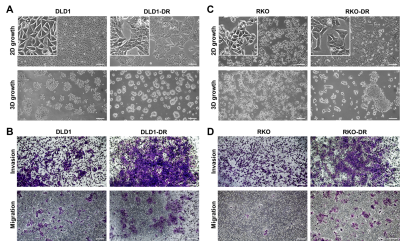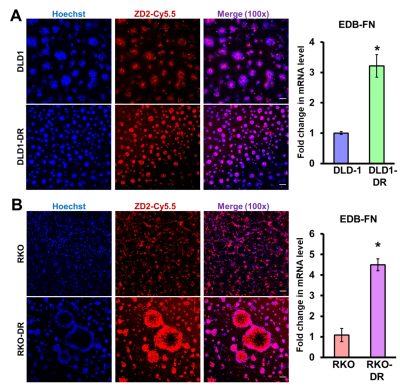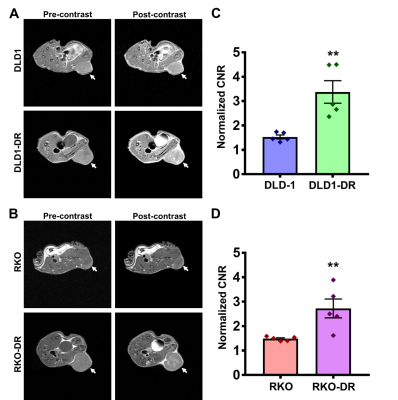0623
MRMI of Extradomain-B Fibronectin for Assessing Drug Resistance in Colon Cancer1Biomedical Engineering, Case Western Reserve University, Cleveland, OH, United States
Synopsis
Non-invasive active surveillance and risk-stratification of drug-resistant colon cancer is imperative, in order to facilitate disease management and tailor therapeutic interventions. This research demonstrates that acquired drug resistance in colon cancer is associated with enhanced expression of extracellular matrix oncoprotein extradomain-B fibronectin (EDB-FN). MR molecular imaging of EDB-FN at a subclinical dose of macrocyclic ZD2-targeted contrast agent ZD2-N3-Gd(HP-DO3A) facilitates effective assessment of drug-resistant colon cancer in two independent models, highlighting the potential of EDB-FN as a diagnostic molecular marker for invasive colon cancer.
Introduction
Colon cancer is the second most common cause of cancer death in men and women combined in the US.1 The 5-year survival for colon cancer cases in 2013 decreased from 88.1% at stage I to 12.6% at stage IV of diagnosis. According to the Center for Disease Control, effective screening can prevent about 60% of deaths caused by colon cancer. Although highly treatable with chemotherapy and surgery in early stages, development of multi-drug resistance can lead to relapse and distant metastases, which are incurable. These facts underscore the importance of non-invasive active surveillance and risk-stratification of invasive colon cancer, to facilitate efficient decision-making for disease management and for tailoring the best possible treatment for a diverse spectrum of patients. While blood markers like carcinoembryonic antigen (CEA) and imaging modalities like PET-CT, MRI, colonoscopy, and ultrasound are commonly used for diagnosis and assessment of the disease,3 they are unable to distinguish between drug-resistant tumors and sensitive ones. To circumvent these concerns, we have developed MR molecular imaging strategies based on the aberrant expression of extradomain-B fibronectin (EDB-FN), an oncofetal isoform of fibronectin.4 This extracellular matrix oncoprotein is significantly upregulated in a plethora of neoplasms including colon cancer, and is associated with epithelial-to-mesenchymal transition (EMT), cancer cell stemness, proliferation, angiogenesis, and metastasis, all of which reflect tumor aggressiveness.6Methods
Drug-resistant DLD1-DR and RKO-DR cells were generated from DLD-1 and RKO colon cancer cells by acquired resistance to 5ʹ-FU and 5ʹ-FU and CB839, respectively. The cells were grown in 2D and 3D Matrigel cultures. Invasion and migration were evaluated using standard transwell assays. mRNA and protein expression of EDB-FN were assessed using qRT-PCR and fluorescent-labeled ZD2-Cy5.5 peptide probe.7 The four cell lines were subcutaneously implanted in the flanks of athymic nu/nu mice (6 week old females) to generate tumor xenografts. MRMI for differential diagnosis of these models was performed using macrocyclic ZD2-targeted contrast agent MT218 [ZD2-N3-Gd(HP-DO3A)]8 on 3T MRS 3000 scanner (MR Solutions). T1-weighted MR images were obtained before and 20 min after injection of 0.04 mmol Gd/kg dose of MT218 using an axial fast spin-echo sequence (TR = 305 ms, TE = 11 ms, FA = 90°, FOV = 40 mm x 40 mm, slice thickness = 1 mm, slice number = 15, Nav = 2, matrix = 256 x 256) with respiratory gating and a mouse short quad coil. Contrast-to-noise ratios (CNRs) were calculated as (mean tumor intensity – mean muscle intensity)/standard deviation of noise. Image and CNR analysis was performed using FIJI.Results and Discussion
With acquired resistance to 5ʹ-FU, DLD-DR cells show morphological changes in 2D culture (Fig 1A) and higher migration and invasion (Fig 1B), compared to their parent DLD-1 cells. With acquired resistance to 5ʹ-FU and CB839, RKO-DR cells show increased propensity to form tumor spheroids in 3D culture (Fig 1C) as well as higher migration and invasion (Fig 1D), compared to RKO cells. The enhanced invasive properties are accompanied by a significant increase in the EDB-FN expression at the protein and mRNA levels in DLD1-DR (Fig 2A) and RKO-DR (Fig 2B) cells, indicating that acquired drug resistance is associated with overexpression of EDB-FN. Contrast-enhanced MRMI using 0.04 mmol Gd/kg of MT218 (40% lower than clinical dose) results in signal enhancement in the non-drug resistant DLD-1 and RKO tumors (Fig 3A-B), reflected in the 1.53- and 1.4-fold higher CNRs than the pre-contrast (Fig 3C-D), respectively. However, the drug-resistant DLD1-DR and RKO-DR models show much more robust signal enhancement, with significantly increased CNRs (2.2- and 1.8-fold) over their non-resistant counterparts, respectively (Fig 3). These results indicate that MRMI of EDB-FN with a significantly reduced dose of MT218 can facilitate effective non-invasive assessment of the development of drug resistance of colon cancer.Conclusions
EDB-FN is a promising diagnostic molecular biomarker for assessing drug resistance in colon cancer. MRMI using ZD2-targeted MT218 has the potential to provide non-invasive active surveillance and risk-stratification of colon cancer. Efficient MRMI at significantly lower doses of MT218 further highlights its safety potential for repeated imaging, particularly for therapeutic monitoring and active surveillance of the disease.Acknowledgements
This research was supported by the National Institutes of Health grants R01CA211762 and R44CA199826.References
1. Siegel RL, Miller KD, Jamal A. Cancer statistics, 2019. CA Cancer J. Clin. 2019;69(1):7-34.
2. Cronin K, Lake AJ, Scott S, et al. Annual report to the nation on the status of cancer, part I: National cancer statistics. Cancer. 2018;124(13):2785-2800.
3. Van Cutsem E, Verheul HM, Flamen P, et al. Imaging in colorectal cancer: progress and challenges for clinicians. Cancers. 2016;8(9):81
4. White ES, Baralle FE, & Muro AF. New insights into form and function of fibronectin splice variants. J. Pathol. 2008;216:1-14.
5. Inufusa H, Nakamura M, Adachi T, et al. Localization of oncofetal and normal fibronectin in colorectal cancer. Correlation with histologic grade, liver metastasis, and prognosis. Cancer. 1995;75(12):2802-8.
6. Petrini I, Barachini S, Carnicelli V, et al. ED-B fibronectin expression is a marker of epithelial-mesenchymal transition in translational oncology. Oncotarget. 2017;8:4914-21.
7. Han Z, Zhou Z, Shi X, et al. EDB fibronectin specific peptide for prostate cancer targeting. Bioconjug. Chem. 2015;26(5):830-838.
8. Ayat N, Qin JC, Cheng H, et al. Optimization of ZD2 peptide targeted Gd(HP-DO3A) for detection and risk-stratification of prostate cancer with MRI. ACS Med Chem Lett. 2018;9(7):730-5.
Figures


